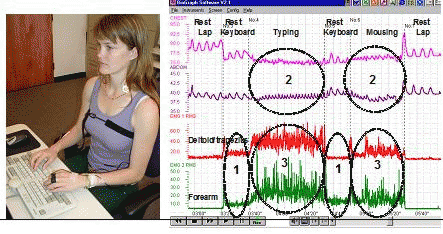Technostress contributes to increasing discomfort and illness at the worksite, especially for those who work at the computer, and can be labeled as "stress immobility syndrome" (Peper & Weijman, 2003; Scaer, 2001). This syndrome occurs when someone works for many hours while stressed, stationary and functionally immobilized with little awareness that this contributes to illness. This paper offers a solution for transforming "technostress' into "technohealth' with the broad goal of reducing illness and improving health and productivity. For example, the most common intervention begins with ergonomic changes so that the person may work in less physically stressful positions. In the case of ergonomics approaches, the correct arrangement for performing the necessary work may include adjusting or changing the chair, keyboard, desk, monitor, as well as light, sound, and all other environmental factors. Even the arrangement of mouse is critical as the mouse use affects arm and shoulder muscle tension. For example, Harvey and Peper (1997) showed that when the pointing device (mouse or trackpad) is located centrally instead of next to the computer keyboard the upper trapezius and anterior deltoid electromyography activity is significantly reduced. Nevertheless, even with the best ergonomic position, illness may still occur, as described in the following vignette (Peper & Gibney, 2007, p. 27).
"Two years after his first ergonomic assessment Mark was still suffering. His employer had followed the recommendations of the ergonomist, purchasing a new chair and keyboard, lowering the monitor, and installing an adjustable workstation with a slant table. Yet, with all these changes, Mark continued to complain of severe and chronic neck pain, tingling down his arms, and aching in his forearm. In fact, his discomfort had increased."
Mark's story is, unfortunately, a very common one. Why, after spending so much money and making the ergonomic corrections, would Mark as well as thousands of other workers still suffer from computer-related disorders? The answer is that technohealth is more than optimizing computer workstation ergonomics. Computer-related injuries tend to occur when employees are captured by their work, engrossed, fixated by the demands of their tasks, and are unaware of, or ignore, physical discomfort, pain or other hurts. For example, in a study by Peper, et al, (2003) almost all employees studied thought that their muscles were relaxed when they were sitting correctly at the computer. However, the actual physiological data showed a different picture. Even while pausing with hands resting on the wrist rest, they did not totally relax their arms and shoulders as shown in Figure 2.
Figure 2 is a representative recording of a person working at the computer. Note the following: 1) forearm and shoulder (deltoid/trapezius) muscle tension increased as the person rests her hands on the keyboard without typing; 2) respiration rate increased during typing and mousing; 3) shoulder muscle tension increased during typing and mousing; and, 4) there were no rest periods in the shoulder muscles as long as the fingers are either resting, typing, or mousing.
Employees working at the computer tend to be unaware of holding chronic, unnecessary muscle tension. Peper et al, (2003) found that 95% of the participants automatically tensed (raised) their shoulders as well as maintained low-level of tension in
their forearms while keyboarding and mousing. Sustaining a posture of tension--raised shoulders, arms reaching forward, rapid shallow breathing, and, sometimes, colder fingers--inhibits the body from relaxation and places the employee at risk of injury. This increased arousal maintains a catabolic/ergothrophic state in which regeneration is constrained. Only when a person relaxes and feels safe does muscle tension decrease and breathing slows. Both psychological as well as physical relaxation promotes the anabolic/trophotropic state during which psychological and physical regeneration may occur (Nixon, 1989).
Both psychological and physical regeneration facilitate technohealth. For example, consider your own patterns of computer equipment use when you wait in anticipation, with your arm extended, finger lifted and ready to click the mouse button. Ask yourself how often while waiting in anticipation does your breathing become more shallow and rapid? Lack of somatic awareness during computer use is a major contributing factor to the development of work-related discomfort. Shumay & Peper (1995) have shown that when working at the keyboard subjects were unaware of their shoulder muscle tension as indicated by a low. (20-25%) correlation between the subjective rating of tension and actual surface electromyographic muscle activity recorded from their trapezius and deltoid muscles. A more important point relevant for understanding technostress was that almost all participants studied thought that their muscles were relaxed when they were sitting correctly at the computer, even though they were tense (Peper et al 2006). Whereas ergonomic changes are necessary, they are insufficient for transforming technostress into technohealth. Employees need to change their somatic patterns and workstyle to reduce stress and enhance health.




